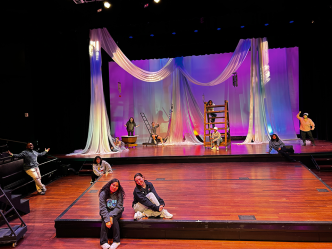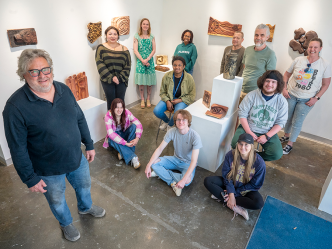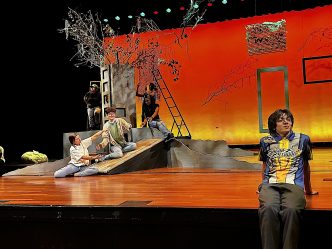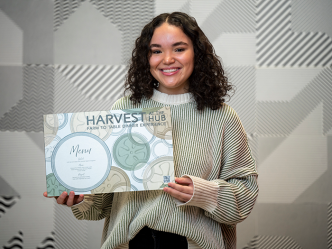Scott Thorp has big plans for Georgia Regents University’s Department of Art, and creativity plays a huge role in what he aims to do.
Thorp, recently named chair of the art department, joined the university in July. Previously, he worked at the Savannah College of Art and Design as a professor and as design coordinator for the school of foundation studies, which focuses on producing well-rounded, capable, creative professionals.
During his time at SCAD, Thorp helped countless students hone their craft, but he also discovered something about himself. He wanted to do more.
“I had a mission change a few years ago,” said Thorp. “Private schools reach a certain part of the population, and they do it well. But state schools cater to a wider selection of students, and that’s what I wanted – to work with a wider selection of students.”
When he saw that GRU was looking for a new art chair, he said the job seemed “just perfect.”
“The way the merger was timed, the way the transition was behind everyone, the art department was looking for a chair,” he said. “Coming on board has been a win-win for me. I’ve really enjoyed every minute of it.”
GRU, in turn, stands to gain a lot from Thorp.
A New Orleans native, Thorp was raised in Atlanta. He attended Georgia State University, where he received a Bachelor of Arts in Drawing and Painting. Later, he attended the Maryland Institute College of Art, where he received his master’s, also in drawing and painting.
After graduating from MICA, Thorp lived and worked as an exhibiting artist in the Mid-Atlantic region of the U.S. There, he said he lived fairly well, though he admitted he made his money in a nonconventional way.
“I was locked in with an architect renovating buildings in D.C.,” said Thorp. “He would come in and buy big paintings for these buildings, which, for artists, are always the hardest to sell.”
After more than a decade of living as an exhibiting artist, Thorp moved to Savannah to begin teaching at SCAD. There, far removed from the artistic culture of bigger cities, Thorp said his studio practice diminished. But something else rose to take its place.
“My writing practice evolved until I became a contributing writer and contributing editor for Art Pulse Magazine, an international art magazine,” said Thorp. “I write and edit for them pretty regularly.”
Thorp also began working on a book that covers his specialty, creativity. The book, “A Curious Path: Creativity in an Age of Abundance” is currently in need of a content editor, but Thorp is hopeful his ideas will sell. After all, that’s just what he spent years teaching his students how to do.
At SCAD, Thorp developed courses and a curriculum around creativity and collaboration, two of the most important educational aspects at SCAD. He said his classes were “training wheels,” in a sense, for students looking to participate in more in-depth programs like those offered at SCAD’s Collaborative Learning Center.
“So, SCAD has the Collaborative Learning Center, which is a pretty active thing,” said Thorp. “SCAD gets these big corporations to come in and fund classes, and students solve problems for these corporations and then come out the other side.”
It was a way for students to learn the practicality of creativity, and a way for them to better understand how to ply it as a trade. That particular problem, Thorp says, hounds creatives. Thankfully, all creatives come with a built-in problem solver: their own creativity.
“We live in an era in which you need creative thinking skills, skills related to design, problem-solving with ill-defined problems,” said Thorp. “In those courses, we really specialized in how to help students generate more ideas first, how to tell what those ideas were about, how to select the best ones, and how to prototype them after.”
The end goal? Creating the best idea possible while maintaining a high level of creativity.
Measuring that creativity, though, was initially a challenge.
“We eventually came up with a definition for creativity,” said Thorp. “We said that creativity was creating something novel, meaning different, and useful, meaning it actually functions in some way.”
Unfortunately, though, not everyone was happy with Thorp having a definition of creativity.
“The funny thing about creativity is that you can really lock it down into strategies and functions really easily,” he said. “Most people like it to be ambiguous, though, so it seems more mysterious. But, really, it becomes more magical when you define it because then people can actually utilize it.”
Another challenge was teaching students the difference between creativity and expression.
“The expression of an idea, if you’re expressive, is your ability to communicate some kind of content, but it can be the same content that’s been created for years,” said Thorp. “So if I paint a really curvy expressive line, it doesn’t mean that that line is a different line from other lines, it just means it has a certain expression quality.”
Art, Thorp says, doesn’t have to be creative to be good. But creativity sells, and that is the essence of his plan for the art department.
“We want to create a creative community,” he said. “Within the department, within the city, with the alumni – everything like that. It’s going to be a larger creative community that we start to generate.”
Thorp’s hope is that if Augusta begins to sell itself as a more creative community, the attention will draw in more students.
“If we have a creative community in the city, including art and design, then art students will want to come here and they’ll want to stay,” he said. “We have a growth model, and we want to grow. And we want to continually improve and continuously support students and faculty in any way we can.”
Thorp says he’s confident his department can live up to that model, especially with the aid of donors like Mary S. Byrd and the Morris Family.
“There’s a lot of support from the community,” said Thorp. “I know I’m being very complimentary, but it’s true – I think the vibe around here is a real positive one.”
 Augusta University
Augusta University



